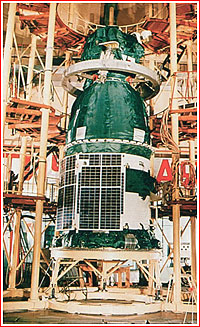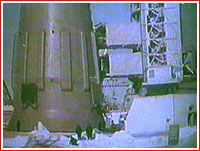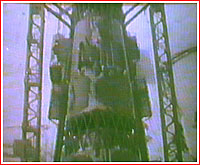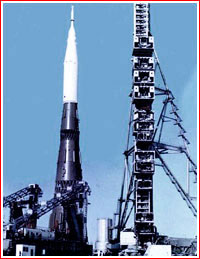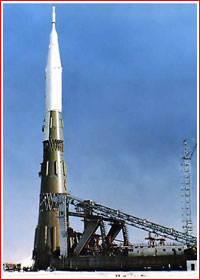Aaaargh! I suppose you could freeze kerosene; the point is there is little to no point in doing so!
I've spent considerable time trying to find out just how much either LOX or kerosene would contract before freezing, and have yet to come up with a definite answer for either.

But I am more convinced than ever--not much.
Kerosene apparently will freeze around -73 C or 200 K. So there is less than 100 degree range between its freezing point and typical "room temperature."
The volumetric coefficient of
gasoline at 20 °C is 950 per million degrees K, so that's actually significant--over a 90 degree span that's 8.55 percent.
But organic liquids have by far the greater coefficients in general. I have yet had no luck in finding a quote for the volumetric coefficient of LOX but I imagine it is far less than gasoline's, and the thermal range between its freezing and boiling point is also quite low, a matter of 45 degrees or so. Since by volume a ker-LOX engine uses twice as much oxygen as hydrocarbon, it will be the lower percentage variation of LOX that dominates.
8 percent for the hydrocarbon (if kerosene resembles gasoline in this respect) is a lot, but there is no point in loading in 1.08 times the kerosene if you can't also load in 1.08 times the oxygen. Well that's not strictly true; one can always run the engine extra fuel-rich, it will lower the ISP but raise the thrust. But overall the amount of mass increase possible by choosing the ultra-coldest temperature for each liquid can't be nearly as much as 8 percent. When we are dealing with 1800 tons, as in the N-1 A stage, even a few percent add up to quite a mass--5 percent would be 90 tons after all!
That's well and good, but by the same token any loss of control of the temperature will mean the extra propellants come flowing out of the over-tight volumes they've been shoehorned into. That's what I meant by regarding a launch hold as disastrous under the circumstances. (Therefore with this harebrained chilled fuel strategy, the launch controllers are under pressure to avoid holds, cross their fingers, and order the launch on schedule, warnings be damned!

)
Now given that, on second thought I suppose the strategy of going ahead and actually
freezing the fuels might not be as crazy as I first thought it was.

Most substances, unlike water, do not expand on freezing but shrink further--but only a little bit. The coefficient of expansion is much lower for solids than liquids, so we aren't going to be able to squeeze in more material by deep-freezing it. But we would gain some margin for delays before the stuff melts and starts expanding again at a serious rate--not only would it be necessary to heat each kilogram of frozen stuff up to the melting point, but then there would be some heat of fusion to input as well.
As it happens the N-1's spherical tanks lend themselves better to this extreme strategy than other tanks might.
Most liquid fuel rocket engines, at least high-efficiency, high power ones like those used here, involve a coolant loop of either the fuel or oxidant running around the combustion chamber and at least the upper part of the nozzle--otherwise the waste heat from the reaction would melt the materials they are made of. I can see an alternative though--what if we used an inert gas with a very broad thermal range, like say helium, in a closed cycle?
We could run cold (compressed gaseous, at high pressure to achieve high density) helium along the rocket exteriors to cool the material, then route the now very hot and even higher pressure gas first through a turbine--this takes some of the edge of the heat off and usefully reuses some of the waste heat to drive the pumps. Then the still-very-hot gas is diverted into two loops, a small one to melt a suitable amount of kerosene and a bigger one for the oxygen. Each parallel path of hot helium goes up to the tank in question, and loops around the bottom of each sphere, with the tubes at such a spacing and of such a size that the bottom of each tank gets heated by the right amount to melt off just the amount of each propellant we need each second; these flow down to the engines each still about as cold as their melting points plus a bit. There the helium from each tank-melting loop flows back, still pretty hot, to heat exchangers that finally cool the helium back down to a cold temperature to close the cycle and once again cool the engine, while the fuels are vaporized as they blast into the engines.
It's tricky; the question is, is the amount of heat we need to absorb from the engines in line with the amount of heat we need to melt the fuels? I gather that generally speaking the limit of how hot a propellant combination can be burned is when whichever propellant we choose for engine coolant is being completely used up as coolant, so the answer would be, yes, pretty closely in line--consider that here we get to use both propellants, both deeply chilled, as coolants rather than being forced to choose one or the other.
If it turns out we actually need more heat than the engine cooling provides to keep the rate of fuel melting up, we can always have an auxiliary combustion chamber that sacrifices some of the propellants just to generate the additional heat. That will lower the efficiency of the engine since we expend those potential propellants without their serving to generate thrust, or at any rate they generate thrust less efficiently, so the ratio of thrust to mass flow needed to generate it is lowered.
Another advantage of this scheme to consider is that if the propellants are indeed frozen solid, then we might be better able to control their sloshing. When the tanks are completely full the stuff can swirl about all it likes and it won't upset the balance of the rocket (though dynamic forces on the tank walls might break them) but when they are partially emptied, sloshing can throw the balance of the rocket off. But if they are solid chunks, with say a light network of cables running through them to the tank wall, their solidity will hold them in place! The tricky thing here is that perhaps instead of smoothly melting off, chunks will stay stubbornly attached to the cables and fail to melt off and fall to the bottom where the heat can melt them. Maybe we can electrically heat the cables as the level of fuel drops to their height?
By going indirect like this with a third fluid we lose some efficiency, but if helium is the third fluid we know we can avoid many thermochemical headaches that using oxygen instead directly in the chamber cooling and in the drive turbine would inflict on us.
So these are advantages of what at first looked like an utterly wrongheaded idea to me, hence my cry of pain!
All this said, if the name of the game is to lower the overall dry weight of the rocket relative to the fuel it contains--I suspect we still have a loser here. I've proposed helium plumbing, containing hot helium at temperatures comparable to those that melt engines and at high pressures demanding considerable strength to contain it (strength compromised by the high temperature too!) running all the way up to the upper kerosene tank, and looping around the bottoms of both tanks, then running back to the engines to be run through heat exchangers there so we can cool it back to the low temperature needed to cool the engines. All of this will add weight; it seems doubtful to me that the few percent we gain in propellant we can contain in a given volume will offset the mass of the helium plumbing.
So if we refrain from actually freezing the fluids and go back to just chilling them, we have no thermal margin.
For the kerosene anyway, one of the major advantages of using it rather than more powerful hydrogen is avoiding the headaches of cryogenics. (Another, probably really the bigger advantage, is density--kerosene would be something like 10-12 times denser than the equivalent mass of LH2, so the tankage is smaller--and if we avoid shenanigans involved with chilling it, we don't need to insulate the tanks either) Oxygen on the other hand must be cryogenic anyway, and it will boil off unless we go beyond merely liquefying it to freeze or near-freeze it--and even that just buys us time, it will heat up and come to a boil anyway after that. I suppose that it is managed on the launching pad by venting off the boil-off and pumping in more LOX, or by accepting that some of the tankage must go to contain some only briefly, before it does boil off.
Perhaps then a hybrid strategy, where we do freeze the LOX, and use something like my helium loop with helium-driven turbines and heat exchangers on the oxygen only? The oxygen is nearly 2/3 the propellant mass and would be doing the lion's share of any cooling, directly or indirectly, anyway, and with the N-1 design the tank is right there at the bottom of the stage next to the engines, so the plumbing to connect the helium coming from each engine to the bottom of the oxy tank would be short. Meanwhile we let the kerosene be at ambient temperature and simply pump it into the engines.
Since as far as I can tell the oxygen would not be much reduced in volume by freezing it versus keeping it near boiling temperatures anyway, this means none of the heroic foolishness of trying to squeeze in more fuel that the OTL N-1 operations were committed to; the fuel is what it is, at ambient temperatures, and the designers just have to live with it.
---
Given the math I did last night, I figure then that if Bahamut's N-1 can only lift just 75 tons to orbit, then the main difference between the OTL figures Wade gives and this timelines lies in a somewhat heavier structure for each stage. I would guess, given what I've managed to learn about the thermal volumetric coefficients of the propellants and the temperature ranges available, that for all their efforts at chilling the fuels they couldn't manage more than a 5 percent increase over the more reasonable temperatures I presume the authors' design plans around. So there is margin for the empty stages to be as much as 20 percent heavier than OTL, which would seem reasonable when we consider that corners were cut to an extreme extent there OTL.
I might run the figures in Silverbird and present them for consideration here tonight.
